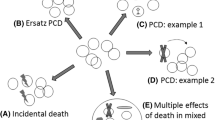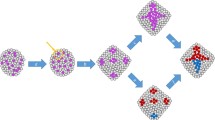Abstract
Discussions of the survival determinism concept have previously focused on its primary role in the evolution of early unicellular organisms in the light of findings which have been reported on a number of diseases. The rationale for such parallel was in the view according to which multicellular organisms could be regarded as sophisticated colonies of semi-autonomous, single-celled entities, whereby various diseases were described as conditions arising upon the activation of the respective survival mechanisms in a milieu unsuitable for such robust stress response. The cellular mechanisms that were discussed in these contexts have been known to play various roles in other biological processes. The proposed notion could thereby be further extended to discussion on mechanisms for the implementation of the respective survival pathways in the development of metazoa, considering that they would have been propagated in their evolution for so long. This manuscript first presents a concise overview of the model previously discussed, followed by the discussion on the role of respective mechanism(s) in origins and development of metazoa. Finally, a reflection on the concept in relation to the prominent evolutionary models is put forward to illustrate a broader context of what is being discussed.

Similar content being viewed by others
References
Baillie JK, Barnett MW, Upton KR, Gerhardt DJ, Richmond TA, De Sapio F, Brennan PM, Rizzu P, Smith S, Fell M, Talbot RT, Gustincich S, Freeman TC, Mattick JS, Hume DA, Heutink P, Carninci P, Jeddeloh JA, Faulkner GJ (2011) Somatic retrotransposition alters the genetic landscape of the human brain. Nature 479:534–537
Buss LW (1983) Evolution, development, and the units of selection. PNAS 80:1387–1391
Buss LW (1987) The evolution of individuality. Princeton University Press, Princeton
Cairns J (1975) Mutation selection and the natural history of cancer. Nature 255(5505):197–200
Cairns J (2006) Cancer and the immortal strand hypothesis. Genetics 174(3):1069–1072
Charlesworth B, Charlesworth D (2009) Darwin and genetics. Genetics 183:757–766
Coufal NG, Garcia-Perez JL, Peng GE, Yeo GW, Mu Y, Lovci MT, Morell M, O’Shea KS, Moran JV, Gage FH (2009) L1 retrotransposition in human neural progenitor cells. Nature 460:1127–1131
Darwin CR (1859) On the origin of species by means of natural selection, or the preservation of favoured races in the struggle for life. John Murray, London
Domazet-Lošo T, Klimovich A, Anokhin B, Anton-Erxleben F, Hamm MJ, Lange C, Bosch TC (2014) Naturally occurring tumours in the basal metazoan Hydra. Nature Commun 5:4222
Eldredge N, Gould SJ (1972) Punctuated equilibria: an alternative to phyletic gradualism. In: Schopf TJM (ed) Models in paleobiology. Freeman, Cooper & Co., San Francisco, pp 82–115
Evan GI, Brown L, Whyte M, Harrington E (1995) Apoptosis and the cell cycle. Curr Opin Cell Biol 7:825–834
Feinberg AP, Ohlsson R, Heinkoff S (2006) The epigenetic progenitor origin of human cancer. Nat Rev Genet 7:21–33
Gagos S, Chiourea M, Christodoulidou A, Apostolou E, Raftopoulou C, Deustch S, Jefford CE, Irminger-Finger I, Shay JW, Antonarakis SE (2008) Pericentromeric instability and spontaneous emergence of human neoacrocentric and minute chromosomes in the alternative pathway of telomere lengthening. Cancer Res 68(19):8146–8155
Garcia-Perez JL, Marchetto MC, Muotri AR, Coufal NG, Gage FH, O’Shea KS, Moran JV (2007) LINE-1 retrotransposition in human embryonic stem cells. Hum Mol Genet 16:1569–1577
Gillespie JH (1984) The molecular clock may be an episodic clock. PNAS 81:8009–8013
Gould SJ, Eldredge N (1977) Punctuated equilibria: the tempo and mode of evolution reconsidered. Paleobiology 3(2):115–151
Greaves M, Maley CC (2012) Clonal evolution in cancer. Nature 481(7381):306–313
Guan D, Zhang W, Zhang W, Liu GH, Belmonte JC (2013) Switching cell fate, ncRNAs coming to play. Cell Death Dis 4:e464
Hull P (2015) Life in the aftermath of mass extinctions. Curr Biol 25(19):R941–952
Huo JS, Zambidis ET (2013) Pivots of pluripotency: the roles of non-coding RNA in regulating embryonic and induced pluripotent stem cells. BBA 1830:2385–2394
Ito K, McGhee JD (1987) Parental DNA strands segregate randomly during embryonic development of Caenorhabditis elegans. Cell 49:329–336
Ito K, McGhee JD, Schultz GA (1988) Paternal DNA strands segregate to both trophectoderm and inner cell mass of the developing mouse embryo. Genes Dev 2:929–936
Jacobs C, Shapiro L (1998) Microbial asymmetric cell division: localization of cell fate determinants. Curr Opin Genet Dev 8(4):386–391
Januschke J, Llamazares S, Reina J, Gonzalez C (2011) Drosophila neuroblasts retain the daughter centrosome. Nat Commun 2:243
Kano H, Godoy I, Courtney C, Vetter MR, Gerton GL, Ostertag EM, Kazazian HH (2009) L1 retrotransposition occurs mainly in embryogenesis and creates somatic mosaicism. Genes Dev 23:1303–1312
Karpowicz P, Morshead C, Kam A, Jervis E, Ramunas J, Cheng V, van der Kooy D (2005) Support for the immortal strand hypothesis: neural stem cells partition DNA asymmetrically in vitro. J Cell Biol 170(5):721–732
Kimura M (1991) Recent development of the neutral theory viewed from the Wrightian tradition of theoretical population genetics. PNAS 88:5969–5973
King N (2004) The unicellular ancestry of animal development. Dev Cell 7(3):313–325
Klar A (1987) Differential parental DNA strands confer developmental asymmetry on daughter cells in fission yeast. Nature 326:466–470
Kono T, Obata Y, Wu Q, Niwa K, Ono Y, Yamamoto Y, Park ES, Seo JS, Ogawa H (2004) Birth of parthenogenic mice that can develop to adulthood. Nature 428(22):860–864
Kretz M, Siprashvili Z, Chu C, Webster DE, Zehnder A, Qu K, Lee CS, Flockhart RJ, Groff AF, Chow J, Johnston D, Kim GE, Spitale RC, Flynn RA, Zheng GX, Aiyer S, Raj A, Rinn JL, Chang HY, Khavari PA (2013) Control of somatic tissue differentiation by the long non-coding RNA TINCR. Nature 493(7431):231–235
Krsmanovic P (2011) Ontological hypothesis of the cancer etiology: discord between cells’ survival determinism and their disposition to biological altruism. Med Hypotheses 77(3):389–400
Krsmanovic P (2013) Fundamental paradox of survival determinism: the ur-etiology disease paradigm. Theory Biosci 132:65–71
Kutschera U (2009a) Symbiogenesis, natural selection, and the dynamic Earth. Theory Biosci 128:191–203
Kutschera U (2009b) Charles Darwin’s Origin of Species, directional selection, and the evolutionary sciences today. Naturwissenschaften 96:1247–1263
Kutschera U, Niklas KJ (2004) The modern theory of biological evolution: an expanded synthesis. Naturwissenschaften 91:255–276
Lewontin RC (1970) The units of selection. Annu Rev Ecol Syst 1:1–18
Liu B, Xue Q, Tang Y, Cao J, Guengerich FP, Zhang H (2016) Mechanisms of mutagenesis: DNA replication in the presence of DNA damage. Mutat Res Rev Mutat Res 768:53–67
Macia A, Muñoz-Lopez M, Cortes JL, Hastings RK, Morell S, Lucena-Aguilar G, Marchal JA, Badge RM, Garcia-Perez JL (2011) Epigenetic control of retrotransposon expression in human embryonic stem cells. Mol Cell Biol 31:300–316
Martínez DE, Bridge D (2012) Hydra, the everlasting embryo, confronts aging. Int J Dev Biol 56:479–487
Mayr E (1954) Change of genetic environment and evolution. In: Huxley J, Hardy AC, Ford EB (eds) Evolution as a process. Allen and Unwin, London, pp 157–180
McConnell MJ, Lindberg MR, Brennand KJ, Piper JC, Voet T, Cowing-Zitron C, Shumilina S, Lasken RS, Vermeesch JR, Hall IM, Gage FH (2013) Mosaic copy number variation in human neurons. Science 342(6158):632–637
Merlo LM, Pepper JW, Reid BJ, Maley CC (2006) Cancer as an evolutionary and ecological process. Nat Rev Cancer 6(12):924–935
Neff MW, Burke DJ (1991) Random segregation of chromatids at mitosis in Saccharomyces cerevisiae. Genetics 127:463–473
Nowell PC (1976) The clonal evolution of tumor cell populations. Science 194(4260):23–28
Ørom UA, Derrien T, Beringer M, Gumireddy K, Gardini A, Bussotti G, Lai F, Zytnicki M, Notredame C, Huang Q, Guigo R, Shiekhattar R (2010) Long noncoding RNAs with enhancer-like function in human cells. Cell 143(1):46–58
Pauli A, Rinn JL, Schier AF (2011) Non-coding RNAs as regulators of embryogenesis. Nat Rev Genet 12(2):136–149
Pereira G, Yamashita YM (2011) Fly meets yeast: checking correct orientation of cell division. Trends Cell Biol 21(9):526–533
Pereira G, Tanaka TU, Nasmyth K, Schiebel E (2001) Modes of spindle pole body inheritance and segregation of the Bfa1p-Bub2p checkpoint protein complex. EMBO J 20:6359–6370
Potten CS, Owen G, Booth D (2002) Intestinal stem cells protect their genome by selective segregation of template DNA strands. J Cell Sci 115(Pt 11):2381–2388
Prusiner SB (1982) Novel proteinaceous infectious particles cause scrapie. Science 216(4542):136–144
Reams AB, Roth JR (2015) Mechanisms of gene duplication and amplification. Cold Spring Harb Perspect Biol 7(2):a016592
Rebollo E, Sampaio P, Januschke J, Llamazares S, Varmark H, Gonzalez C (2007) Functionally unequal centrosomes drive spindle orientation in asymmetrically dividing drosophila neural stem cells. Dev Cell 12(3):467–474
Rocheteau P, Gayraud-Morel B, Siegl-Cachedenier I, Blasco MA, Tajbakhsh S (2012) A subpopulation of adult skeletal muscle stem cells retains all template DNA strands after cell division. Cell 148(1–2):112–125
Rujano MA, Bosveld F, Salomons FA, Dijk F, van Waarde MA, van der Want JJ, de Vos RA, Brunt ER, Sibon OC, Kampinga HH (2006) Polarised asymmetric inheritance of accumulated protein damage in higher eukaryotes. PLoS Biol 4(12):e417
Ryan FP (2004) Human endogenous retroviruses in health and disease: a symbiotic perspective. J R Soc Med 97(12):560–565
Sadakierska-Chudy A, Filip M (2015) A comprehensive view of the epigenetic landscape. Part II: Histone post-translational modification, nucleosome level, and chromatin regulation by ncRNAs. Neurotox Res 27(2):172–197
Schimke RT, Kaufman RJ, Alt FW, Kellems RF (1978) Gene amplification and drug resistance in cultured murine cells. Science 202:1051–1055
Schröder R, Schoser B (2009) Myofibrillar myopathies: a clinical and myopathological guide. Brain Pathol 19(3):483–492
Sherman MY, Goldberg AL (2001) Cellular defenses against unfolded proteins: a cell biologist thinks about neurodegenerative diseases. Neuron 29(1):15–32
Shinin V, Gayraud-Morel B, Gomès D, Tajbakhsh S (2006) Asymmetric division and cosegregation of template DNA strands in adult muscle satellite cells. Nat Cell Biol 8(7):677–687
Smith GH (2005) Label-retaining epithelial cells in mouse mammary gland divide asymmetrically and retain their template DNA strands. Development 132(4):681–687
Tomasetti C, Vogelstein B (2015) Variation in cancer risk among tissues can be explained by the number of stem cell divisions. Science 347(6217):78–81
van den Hurk JA, Meij IC, Seleme MC, Kano H, Nikopoulos K, Hoefsloot LH, Sistermans EA, de Wijs IJ, Mukhopadhyay A, Plomp AS, de Jong PT, Kazazian HH, Cremers FP (2007) L1 retrotransposition can occur early in human embryonic development. Hum Mol Gen 16:1587–1592
Watanabe T, Takeda A, Tsukiyama T, Mise K, Okuno T, Sasaki H, Minami N, Imai H (2006) Identification and characterization of two novel classes of small RNAs in the mouse germline: retrotransposon-derived siRNAs in oocytes and germline small RNAs in testes. Genes Dev 20:1732–1743
Williamson DH, Fennel DJ (1981) Non-random assortment of sister chromatids in yeast mitosis. In: von Wettstein D et al (eds) Molecular genetics in yeast, Alfred Benzon Symposium, vol 16. Munksgaard, Copenhagen, pp 89–102
Yamashita YM, Mahowald AP, Perlin JR, Fuller MT (2007) Asymmetric inheritance of mother versus daughter centrosome in stem cell division. Science 315:518–521
Funding
Preparation of this manuscript was not supported by any third-party funding sources.
Author information
Authors and Affiliations
Corresponding author
Ethics declarations
Conflict of interest
The author declares that he has no conflict of interest.
Rights and permissions
About this article
Cite this article
Krsmanovic, P. Vigor of survival determinism: subtle evolutionary gradualism interspersed with robust phylogenetic leaping. Theory Biosci. 136, 141–151 (2017). https://doi.org/10.1007/s12064-017-0251-4
Received:
Accepted:
Published:
Issue Date:
DOI: https://doi.org/10.1007/s12064-017-0251-4




